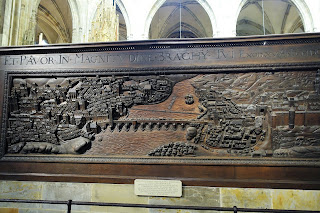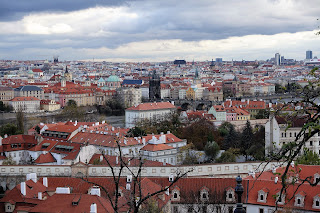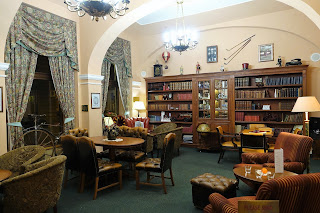Looking out over Prague from the Great South Tower
Another day, another castle (or old town, or both). Prague's is pretty impressive, I gotta admit. Beginning with the first fortified settlement in the 9th century, Czech leaders have ruled from its roosts for more than a thousand years (the official residence of the President of the Czech Republic is part of the castle complex). The periodic reconstructions undertaken at various points in the castle's history (the last being in the 18th century) have left the castle with an eclectic mix of architectural styles, and have helped make it justifiably Prague's most popular tourist attraction.
We made our visit on Halloween, taking the tram for the uphill ride to a stop near the castle's entrance. Entering the first of several courtyards, we passed by one of the castle guards standing at attention. There's a changing of the guard every hour that we managed to miss:
The girls in the Second Courtyard, with its baroque fountain and 17th-century well:
The highlight of any visit to Prague Castle has to be St. Vitus Cathedral, home to the tombs of Bohemian rulers and saints:
Though the cathedral's foundation stone was laid way back in 1344, work to finish the project didn't begin in earnest until 1861, with the church finally being consecrated in 1929:
One of the first things you notice upon entering the nave is the stained glass windows dating from the early 20th century, with the most famous one being by Alfons Mucha and depicting the lives of Sts. Cyril and Methodius:
A carved-wood relief of Prague from 1630 depicting the city as it looked in 1620, when the Habsburg armies defeated the Protestant King Frederic in the Battle of White Mountain:
The baroque tomb of St. John of Nepomuk, made with the assistance of two tons of silver:
The beautiful 16th-century Chapel of St. Wenceslas, with its wall paintings depicting scenes from the life of the Czechs' patron saint:
Next up was the Great South Tower, which according to my Lonely Planet guide was left unfinished in the 15th century, with a Renaissance gallery added in the late 16th century and a spire dating from the 1770's:
297 steps lead to the top and some fine views:
Echoes of the Communist past visible in the distance:
Back on terra firma, we sauntered over to the Old Royal Palace, dating from 1135 and used by Czech kings from the 13th to 16th centuries. The Vladislav Hall was the setting for banquets, councils, coronations - and indoor jousting tournaments:
Time out for lunch. Beef goulash in a bread bowl...and beer:
The Basilica of St. George, established in the 10th century, though what visitors see today is the result of restorations made in the late 19th- and early 20th-centuries:
This creepy 16th-century statue of a decomposing corpse is an allegory of Vanity - according to legend, an Italian sculptor murdered his girlfriend, only to create the sculpture of her rotting corpse out of feelings of remorse after her buried body was discovered. Cool:
Gruesome folklore didn't stop my wife from working up an appetite and needing a snack break:
The Golden Lane is a picturesque alley included in the admission ticket for Prague Castle:
The cottages there were put up in the 16th century, and were eventually used in the 19th and early 20th centuries by artists. Many of the houses have been restored to show some of their former uses:
No. 22 was the former home of the sister of Franz Kafka - the writer frequently visited there from 1916 to 1917. It's now a bookshop where I purchased a copy of The Metamorphosis for Amber. It's never too early to start:
Color me unimpressed:
Taking in more views as we headed downhill from the castle:
My daughter takes a well-earned trdelník break (the addition of ice cream is a modern touch):
Shu-E was feeling tired by this point (who can blame her?), so she and Amber caught a tram back to our hotel:
I, on the other hand, still had energy to burn and so I headed off to the fascinating Franz Kafka Museum. Sure, it's pretentious as all fuck, but the museum does an excellent job of exploring the relationship between the writer and the city, through the use of letters, photographs and some creepy sound/video installations. I was most impressed with the file cabinet hallways, which serve to emphasize the claustrophobic bureaucracy that is woven through some of Kafka's most famous works. It's too bad photography isn't permitted (ahem):
Visiting the museum seemed especially apropos as I was going through my own version of The Trial at that moment, stuck in a...wait for it...Kafkaesque (!) bureaucratic limbo of not knowing where my next post was going to be. Call me K:
I decided to walk back to our hotel afterward, rather than taking the tram:
The Malá Strana Bridge Tower at the western end of the Charles Bridge:
The Hotel Julian, home for our first four nights in Prague:
My wife often eschews dinner these days, so I took my daughter out on a dinner date to the nearby Pizzeria Capretto for a break from Czech cuisine:
The Memorial to the Victims of Communism. Much like Lithuanians, Czechs understandably don't look back at the period from 1948 to 1989 with a great deal of fondness:
Back at the hotel, where the downstairs drawing room takes visitors back to 1905:



















































No comments:
Post a Comment